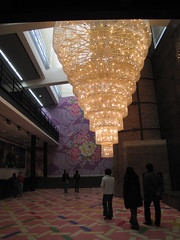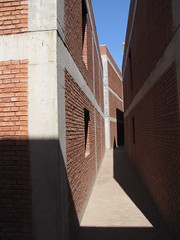Ai Weiwei
I have for a long time wanted to see the work of Ai Weiwei. I have seen his constructions, a giant crystal chandelier at UCCA in 798 art district and the studio building complex at Caochangdi art district in Beijing. But I had not yet seen the broken artefacts. I have found it hard to believe that he really, actually destroys several centuries' old vases. Now I have seen it with my own eyes.


Chandelier at UCCA * Artist studios /exhibition spaces at Caochangdi
(I promised not to publish my own photos from the exhibition, so instead you may have a look at the gallery webpage: http://faurschou.com/artists/aiweiwei/)


Chandelier at UCCA * Artist studios /exhibition spaces at Caochangdi
(I promised not to publish my own photos from the exhibition, so instead you may have a look at the gallery webpage: http://faurschou.com/artists/aiweiwei/)
In a fashionable part of Copenhagen, just some few blocks from the Royal Palace, into a courtyard, up a carpet-clad staircase in a beautiful Jugend-style building, is Faurschou Gallery. It is not exactly the neighbourhood I would expect to find contemporary Chinese art. Faurschou actually run another gallery, in the 798 art district in Beijing, so the Chinese connection is definitely present.
The exhibition consists of a shelf of jars filled with the powder of crushed neolithic pottery (5000-3000BC). One vase is adorned with the Coca-Cola logo. A large installation of vases only partly painted, but together they make a whole, is occupying a large portion of the floor. And there is a pile of what appears to be sunflowerseeds on the floor. It is actually a vast amount of ceramic hand-painted sunflowerseed sculptures. This is only a miniature version of the parallell exhibition at Tate Modern Turbin Hall in London, where a giant space of 1000 square meters is filled with ceramic seeds. That is 100 000 000 seeds hand painted by 1600 people!
Ai Weiwei is probably the most internationally known Chinese contemporary artist. He is both a destroyer and a constructor through his artwork. He is famous for installations, architecture, but also for performances and installations that demands destroing old artefacts like old vases and materials from old buildings. Through his artwork he act as a strong voice on social and society questions both on the domestic and international scene.
On one hand he is lifting up contemporary art by creating studio and exhibition buildings. On the other hand he is destroying ancient art by smashing vases to the floor. The latter is almost unthinkable, imagine an irreplaceble artefact destroyed forever in a second! But this of course leads to a lot of questions. How many vases are needed to save the history? Do we need to save only one, or 10 similar artefacts, or maybe 100, to have a sufficient record of the ancient culture? How many vases can Ai Weiwei destroy before the history is threatened? And what about all other artefacts being destroyed by ignorance and construction work? Is that a worse form of destruction? Or maybe because something new is constructed, it is allowed? Is not also Ai Weiwei creating something new, a new artwork, through the destruction?
But then again, is the history worth remembering? Most Chinese probably live a better life nowadays than when these vases were made. Many rulers have started their reign by destroying the memories of the former rulers. Is that what is happening here? Like the Coca-cola decorated vase. Is it "same shit, new wrapping", the same system, but with another rule?
These questions become very interesting while reading the latest news about Ai Weiwei. Some of his newly constructed studio buildings in Shanghai were surprisingly destroyed by bulldosers. Where he had been the constructer, the rulers became the destructors. Also was he not allowed travel out from China to attend to the vernissage of his shows, apparently based on the fear of him turning up at the peace price ceremony in Oslo. In a way his life become art along with his artwork.
Some links to current exhibitions and news about Ai Weiwei: